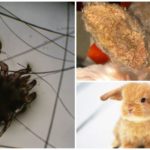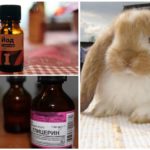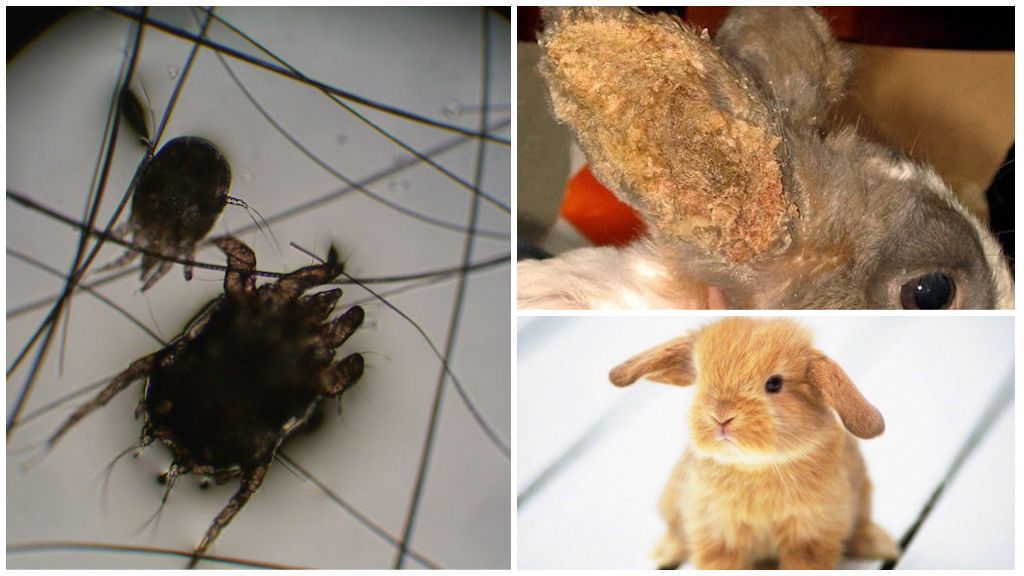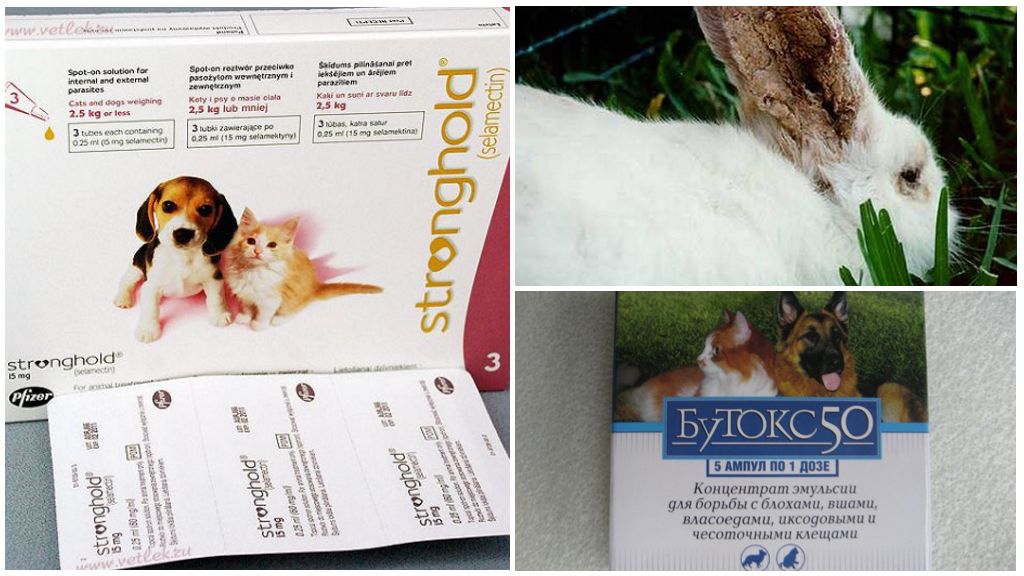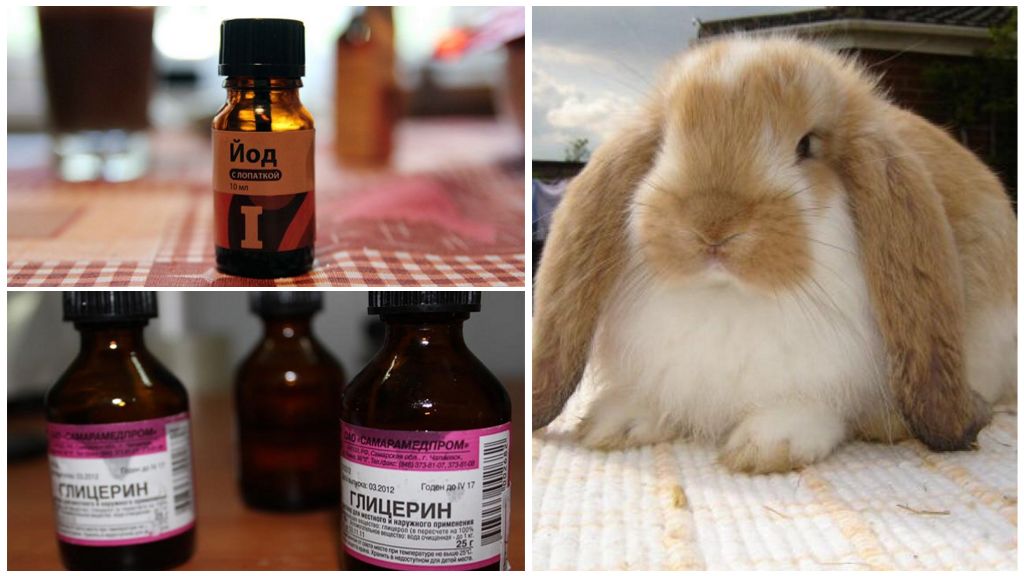Treatment of ear mite in rabbits
Content
- Rabbit Ear Tick
- Preparations against ear mite
- Folk methods of dealing with ear mites
For rabbits, ears are not only necessary for hearing, but are also a means for thermoregulation and communication with the environment. Therefore, any disease of such an important organ leads to a decrease in the quality of life of a fluffy pet. Ear tick in rabbits causes the disease psoroptosis, which can quickly progress and lead to the death of the animal. Therefore, immediately after the discovery of the parasite, urgent treatment is necessary.
Causative agent
Scabies or psoroptosis in rabbits causes the subcutaneous ear mite Psoroptes cuniculi, which parasitizes the surface of the hearing organs, causing unpleasant itching and inflammation. These parasites have a rounded elongated shape and yellow color. Very small, size 0.2-0.8 mm.
On a note!
The ear mites feed on blood, lymph and remnants of the skin, which is pierced to lay strokes in it.
After a rabbit has bitten a tick, there is a violation of the integrity of the tissues of the epidermis of the organs of hearing. With the active reproduction of parasites in a sick pet, the inflammatory process and other health complications begin:
- weakening of immunity;
- hormonal imbalance, which affects the appearance of offspring: females refuse to feed babies, and males are not capable of mating;
- pet weight loss;
- possible development of tumors in the brain with the further spread of infection in the ear canal and in the eardrum;
- increases the risk of secondary infection and damage to the nervous system, which threatens the death of the animal.
Ways of infection
An outbreak of ear scabies occurs in the period of autumn and winter.
Ticks in a rabbit in the ear can appear in several ways:
- from a sick animal in the house (dogs, cats, etc.);
- through the clothes of the owner, where the mite falls on the street;
- through contaminated objects or toys.
The organs of hearing in a rabbit have many blood vessels, which are poorly protected by thin hair, which serves as a lure for parasites. Getting to the surface of the ears, the mites find an environment favorable for reproduction, laying eggs directly into the passages built in the tissues of the epidermis.
On a note!
The most at risk are rabbits at the age of 4 months, which can be infected by their mother. Adults most often "receive" ear mites when in contact with other animals or from humans.
Symptoms of psoroptosis
The first signs of ear scabies do not appear in pets immediately; the incubation period is 5 days. Then the following symptoms become noticeable:
- restless behavior, loss of appetite, refusal to play;
- the rabbit shakes and shakes his head, tries to scratch his ears from the inside with his back paw;
- on the inside of the hearing organs, red blisters and ulcers can be seen that can burst, forming wounds and crusts;
- to the touch they are hot and painful, the walls swell and thicken;
- due to the accumulation of sulfur, overlap of the ear canal may occur;
- if a rabbit has non-clipped claws, then due to active scratching wounds and crusts are formed, with a large area of pathogenic bacteria multiply and tend to penetrate deeper into the brain.
Important!
Ignoring such symptoms of the disease by the host can lead to a strong reproduction of fur mites in rabbits and their death within a few months. In the presence of complications it is necessary to conduct long-term treatment.
Diagnostic methods
You can see and view the ear mite at home with a magnifying glass and some accessories.
For the procedure for diagnosing ear mites, you will need:
- a piece of glass for analysis;
- heated vaseline to + 40 ° C;
- durable, thin and non-sharp tools that are scraped;
- Magnifier or magnifying glass, but a microscope is better.
After taking the scraping, it is placed on the glass and dripped on top with hot vaseline. When considering the material obtained under a magnifying glass, swarming yellow parasites, their eggs and larvae are noticeable, which indicates the pet's illness by psoroptosis.
On a note!
You can do the analysis in the laboratory, where the ears of the pet are also examined using an otoscope or x-ray.
Medical treatments
With the help of pharmaceutical preparations, the treatment of ear mites in rabbits is carried out with high efficiency in a few days.
On a note!
Before you start using any popular or medicinal products, you should always consult with a veterinarian.
The most common medicines are:
- Spray (Cyodrin, Psorotop, Dikrasil, Acrosil, Dermatosol, etc.) is the most convenient form that allows you to quickly and easily cope with the disease: it is recommended to spray the aerosol over the skin surface at a distance of 10-15 cm for 2 sec. The number of treatments - 2-3 with an interval of 7-10 days, after the first procedure, 80% of ticks die.
- Ivermectin, Selamectin, etc. - are applied as a subcutaneous injection into the base of the ear.
- Stronghold - an anti-parasitic agent against ticks for rabbits and other domestic animals in the form of drops in a pipette of 0.25 ml.
- Emulsions and drops: Valekson, Butoks-50 - are sold as ampoules with a solution for irrigation of the organs of hearing, before the procedure, dilute in 1 liter of water.
- Dekta - buried in the ears of a sick animal.
- Yam ointment, a bactericidal acaricidal agent that has antiseptic and fungicidal effects against ear mites and other parasites, is applied with a thin layer on the inner surfaces of the ears twice a day before the scabs are separated, and within 7-10 days the affected areas are cleaned of crusts.
Important!
All antiparasitic treatments of cells and sick animals should be carried out only with gloves to prevent the transfer of ear mites to hands. Remove crusts and scabs to collect in a special container, because there are many parasites. After the procedure, they must be poured chlorine or burn.
Folk methods
Treatment of ear scabies using folk remedies is a longer and laborious process and is intended to soften the scab and further purify the ear canal from the mites themselves. Processing should be carried out with an interval of 2-3 days several times.
To treat ear mite in rabbits can be prepared mixtures:
- pre-clean the ear canal will help a mixture of glycerin and iodine in a ratio of 4: 1, it is better to carry out cleaning daily;
- to soften the skin and crusts, spread them with a therapeutic mixture of turpentine, creolin, vegetable oil and kerosene;
- camphor oil should be collected in a syringe (without a needle) and the inner surfaces of the ears should be irrigated: the film from this agent will block the respiratory tract for parasites, as a result of which they tend to get to the surface of the skin where they can be easily destroyed;
- gel from vegetable oil and turpentine in a ratio of 1: 2 - is applied similarly.
On a note!
These home remedies require a more time-consuming and lengthy treatment process compared with medications, however, they are more harmless to the body of rabbits.
Preventing the onset of psoroptosis
In order to prevent the disease of domestic rabbits with ear scabies, it is necessary to regularly examine animals and carry out a set of measures to destroy parasites in the places of their life:
- to observe the hygienic rules of keeping pets, to prevent their crowding;
- regularly clean and treat rabbit cells with Creolin 5% solution or Hexochloran-Creolin emulsion, which will destroy eggs and larvae of ear mites;
- purchased "newbies" quarantine for 10-14 days;
- 2 weeks before giving birth, process pregnant female rabbits to avoid infecting babies.
For a successful and effective crawl to recover, it is necessary to respond in time to the non-standard behavior of the pet in order to quickly detect the disease at the initial stage, start the treatment of psoroptosis and prevent further spread of the inflammatory process to the brain and into the body of the animal.

